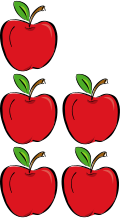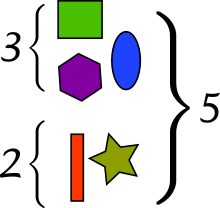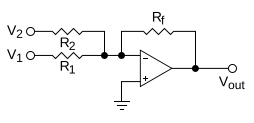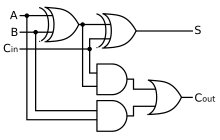Pengguna:Dedhert.Jr/Uji halaman 01/5

Penambahan (yang biasnaya ditandai dengan simbol plus +) merupakan salah satu dari empat operasi dasar aritmetika, tiga operasi lainnya adalah pengurangan, perkalian, dan pembagian. Penambahan dari dua bilangan cacah memberikan jumlah dari nilai yang ditambahkan. Misalnya pada gambar berikut memperlihatkan terdapat tiga apel dan dua apel, menghasilkan jumlah sebanyak lima apel. Dalam matematika, hal tersebut dapat diekspresikan sebagai "3 + 2 = 5" (dibaca, "3 ditambah 2 sama dengan 5").
Selain menghitung benda, penambahan juga dapat didefinisikan dan digunakan untuk menghitung benda-benda yang abstrak berupa bilangan, seperti bilangan bulat, bilangan real dan bilangan kompleks. Penambahan merupakan bagian dari sebuah cabang matematika, yaitu aritmetika. Penambahan dalam cabang lainnya, aljabar, juga dapat didefinisikan untuk hal-hal yang abstrak seperti vektor, matriks, subruang, dan subgrup.
Penambahan juga mempunyai beberapa sifat yang penting. Yang pertama adalah komutatif, yang berarti bahwa urutan tidak dipermasalahkan, dan yang kedua adalah asosiatif, yang berarti bahwa ketika sebuah bilangan ditambahkan lebih dari dua bilangan, urutan penjumlahannya tidak dipermasalahkan (lihat Penjumlahan). Penambahan berulang dari 1 sama saja dengan pencacahan. Penambahan dari 0 tidak mengubah sebuah bilangan. Penambahan juga mematuhi aturan-aturan yang terkait dengan pengurangan dan perkalian.
Menghitung operasi penambahan merupakan salah satu pekerjaan yang paling mudah. Bahkan anak kecil dapat menghitung penambahan dari bilangan yang sangat kecil. Sebagai contoh, soal berhitung yang paling mendasar, 1 + 1, dapat dilakukan oleh seorang bayi berumur lima bulan, dan bahkan dapat dilakukan oleh anggota spesies hewan lainnya. Para siswa yang duduk di bangku dasar diajarkan cara menjumlahkan bilangan melalui sistem desimal, dimulai dari menghitung penjumlahan dari satu digit hingga menangani soal-soal yang semakin sulit. Pelaksanaan terkait penelitian dalam menghitung penambahan lebih cepat melalui alat bantu, seperti sempoa pada zaman kuno hingga komputer pada zaman kini, berlanjut hingga saat ini.
Notasi dan istilah[sunting | sunting sumber]

Operasi penambahan ditulis menggunakan notasi infiks, sebuah notasi yang menuliskan tanda plus "+" diantara suku-suku.[2] Hasil penjumlahan dapat dinyatakan dengan sebuah tanda sama dengan. Sebagai contoh,
- ("satu ditambah satu sama dengan dua")
- ("dua ditambah dua sama dengan empat")
- ("satu ditambah dua sama dengan tiga")
- (lihat asosiatif)
- (lihat perkalian)

Adapula situasi ketika tanda plus tidak ditulis pada operasi penambahan, namun konteksnya masih "dipahami". Misalnya, bilangan campuran, penjumlahan antara bilangan cacah dengan pecahan.[3]
Jumlah dari deret dari bilangan yang berkaitan dapat dinyatakan melalui sebuah penyingkatan operasi berulang, notasi Sigma. Sebagai contoh,
Umumnya dalam penambahan, bilangan atau bentuk matematika yang ditambahkan mengacu pada kumpulan dari suku,[5] penambah[5] (atau tinambah)[6], atau jumlah.[5] Istilah ini memperluas penjumlahan dari suku yang banyak, yang berbeda dengan faktor.
Simbol plus "+" (Unicode:U+002B; ASCII: +) merupakan singkatan dari kata Latin et, yang berarti "dan".[7] Simbol ini muncul dalam karya matematika yang setidaknya berasal dari tahun 1489.[8]
Pandangan[sunting | sunting sumber]
Penambahan dipakai untuk menggambarkan banyaknya proses fisik. Bahkan untuk kasus sederhana dalam menambahkan bilangan asli, ada banyak kemungkinan pandangan dan bahkan lebih banyak representasi visual.
Menggabungkan kumpulan benda[sunting | sunting sumber]

Pandangan yang paling dasar adalah bahwa penambahan dipandang sebagai menggabungkan himpunan:
Ketika ada dua kumpulan terpisah atau lebih digabungkan menjadi satu kumpulan, maka jumlah benda dalam kumpulan tersebut merupakan jumlah benda dalam kumpulan-kumpulan sebelumnya.
Pandangan ini mudah dilihat, namun bahayanya adalah bahwa pandangan ini memberikan sedikit ambigu. Pandangan ini juga berguna dalam matematika tingkat lanjut (lihat § Bilangan asli untuk definisi cermatnya). Sayangnya, pandangan ini belum jelas mengenai bagaimana cara memperluas untuk penambahan terkait bilangan pecahan ataupun bilangan negatif.[9]
Cara yang dapat memperbaiki pandangan ini adalah dengan memandang kumpulan benda yang dapat dibagi dengan mudah, seperti kue pie, atau lebih mudahnya, batang beruas.[10] Tanpa menggabungkan kumpulan ruas, batang-batangnya dapat disambungkan pada ujung batang ke ujung batang lain, yang menggambarkan konsep dari penambahan lainnya: penambahan bukanlah batang, melainkan panjang dari batang.
Memperluas panjang garis bilangan[sunting | sunting sumber]
Pandangan yang kedua tentang penambahan diawali dengan memperluas panjang awal dengan panjang yang diberikan:
Ketika panjang awal diperluas dengan panjang yang diberikan, maka panjang akhirnya merupakan jumlah dari panjang awal dan panjang yang diperluas.[11]
Dalam pengertian aljabar, jumlah a + b dapat dipandang sebagai operasi biner yang menggabungkan a dan b, atau dapat dipandang sebagai b yang menambahkan banyak satuan ke a. Dalam pandangan ini, bagian dari jumlah a + b memainkan peran asimetrik, dan operasi a + b dipandang sebagai menerapkan operasi uner +b ke a.[12]
Sifat-sifat penambahan[sunting | sunting sumber]
Sifat komutatif[sunting | sunting sumber]
Penambahan bersifat komutatif, yang berarti urutan pada penjumlahan dapat ditukar, tetapi masih memberikan hasil yang sama. Melalui lambang, jika a dan b adalah bilangan, maka
- .
Penambahan yang bersifat komutatif dikenal sebagai "hukum penambahan komutatif" atau "sifat penambahan komutatif". Ada beberapa operasi biner yang bersifat komutatif seperti perkalian, tetapi ada banyak operasi yang tidak mempunyai sifat tersebut seperti pengurangan dan pembagian.
Sifat asosiatif[sunting | sunting sumber]
Penambahan bersifat asosiatif, yang mengartikan ketika ada tiga bilangan atau lebih yang ditambahkan, operasi yang diurutkan tidak mengubah hasil. Dengan kata lain, a + b + c didefinisikan sebagai (a + b) + c atau a + (b + c), yang berarti
Sebagai contoh, (1 + 2) + 3 = 3 + 3 = 6 = 1 + 5 = 1 + (2 + 3).
Ketika operasi penambahan dipakai dengan operasi lain, maka urutan operasi menjadi penting. Dalam urutan operasi yang standar, eksponensial, akar ke-n, perkalian dan pembagian lebih diutamakan dibandingan dengan penambahan (dan bahkan pengurangan).[13]
Elemen identitas[sunting | sunting sumber]

Ketika suatu bilangan ditambahkan dengan nol, maka bilangan tersebut tidak berubah. Hal ini mengartikan bahwa nol merupakan elemen identitas untuk penambahan, dan juga dikenal sebagai identitas penambahan. Melalui simbol, untuk setiap a, maka
Hukum ini pertama kali diidentifikasi dalam karya Brahmagupta, Brahmasphutasiddhanta, pada 628 SM, walaupun ia memisahkan ketiga hukum yang ditulis, yakni hukum tersebut bergantung pada a yang bernilai negatif, positif, atau nol tersendiri. Penulisan tersebut dipakai menggunakan kata alih-alih simbol aljabar. Para matematikawan India kemudian memperkuat konsep dari penambahan. Sekitar tahun 830 SM, Mahavira menulis, "nol menjadi sama ketika menambahkan ke bilangan", yang sesuai dengan pernyataan uner 0 + a = a. Hal ini disesuaikan pula pada abad ke-12 ketika Bhaskara menulis, "Dalam penambahan atau pengurangan digit, jumlah baik bernilai positif maupun negatif, tetap bernilai sama", yaitu a + 0 = a.[14]
Penerus[sunting | sunting sumber]
Dalam konteks bilangan bulat, penambahan dari 1 juga memainkan peran khusus: untuk suatu bilangan bulat a, bilangan bulat a + 1 yang merupakan bilangan bulat terkecil yang lebih besar dari a, juga dikenal sebagai penerus dari a.[15] Sebagai contoh, 3 merupakan penerus dari 2, dan 7 merupakan penerus dari 6. Karena adanya penerus bilangan tersebut, nilai a + b juga dapat dipandang sebagai penerus ke-b dari a, yang membuat penambahan sebagai penerus teriterasi. Sebagai contoh, 6 + 2 sama dengan 8, karena 8 merupakan penerus dari 7, yang merupakan penerus dari 6, sehingga membuat 8 merupakan penerus kedua dari 6.
Satuan[sunting | sunting sumber]
Untuk menambahkan kuantitas secara numerik melalui satuan, maka nilai-nilainya harus dibentuk dengan satuan yang sama.[16] Sebagai contoh, menambahkan 50 milliliter ke 150 milliliter memberikan 200 milliliter. Namun, jika ukuran 5 kaki diperluas dengan 2 satuan, jumlahnya menjadi 62 inci, karena 60 inci sama dengan 5 kaki. Di sisi lain, menambahkan 3 meter dengan 4 meter persegi biasanya tidak dapat dilakukan, karena kedua satuan tersebut tidak sama; hal tersebut merupakan fundamental dalam analisis dimensional.[17]
Performing addition[sunting | sunting sumber]
Innate ability[sunting | sunting sumber]
Studies on mathematical development starting around the 1980s have exploited the phenomenon of habituation: infants look longer at situations that are unexpected.[18] A seminal experiment by Karen Wynn in 1992 involving Mickey Mouse dolls manipulated behind a screen demonstrated that five-month-old infants expect 1 + 1 to be 2, and they are comparatively surprised when a physical situation seems to imply that 1 + 1 is either 1 or 3. This finding has since been affirmed by a variety of laboratories using different methodologies.[19] Another 1992 experiment with older toddlers, between 18 and 35 months, exploited their development of motor control by allowing them to retrieve ping-pong balls from a box; the youngest responded well for small numbers, while older subjects were able to compute sums up to 5.[20]
Even some nonhuman animals show a limited ability to add, particularly primates. In a 1995 experiment imitating Wynn's 1992 result (but using eggplants instead of dolls), rhesus macaque and cottontop tamarin monkeys performed similarly to human infants. More dramatically, after being taught the meanings of the Arabic numerals 0 through 4, one chimpanzee was able to compute the sum of two numerals without further training.[21] More recently, Asian elephants have demonstrated an ability to perform basic arithmetic.[22]
Childhood learning[sunting | sunting sumber]
Typically, children first master counting. When given a problem that requires that two items and three items be combined, young children model the situation with physical objects, often fingers or a drawing, and then count the total. As they gain experience, they learn or discover the strategy of "counting-on": asked to find two plus three, children count three past two, saying "three, four, five" (usually ticking off fingers), and arriving at five. This strategy seems almost universal; children can easily pick it up from peers or teachers.[23] Most discover it independently. With additional experience, children learn to add more quickly by exploiting the commutativity of addition by counting up from the larger number, in this case, starting with three and counting "four, five." Eventually children begin to recall certain addition facts ("number bonds"), either through experience or rote memorization. Once some facts are committed to memory, children begin to derive unknown facts from known ones. For example, a child asked to add six and seven may know that 6 + 6 = 12 and then reason that 6 + 7 is one more, or 13.[24] Such derived facts can be found very quickly and most elementary school students eventually rely on a mixture of memorized and derived facts to add fluently.[25]
Different nations introduce whole numbers and arithmetic at different ages, with many countries teaching addition in pre-school.[26] However, throughout the world, addition is taught by the end of the first year of elementary school.[27]
Table[sunting | sunting sumber]
Children are often presented with the addition table of pairs of numbers from 0 to 9 to memorize. Knowing this, children can perform any addition.
| + | 0 | 1 | 2 | 3 | 4 | 5 | 6 | 7 | 8 | 9 |
|---|---|---|---|---|---|---|---|---|---|---|
| 0 | 0 | 1 | 2 | 3 | 4 | 5 | 6 | 7 | 8 | 9 |
| 1 | 1 | 2 | 3 | 4 | 5 | 6 | 7 | 8 | 9 | 10 |
| 2 | 2 | 3 | 4 | 5 | 6 | 7 | 8 | 9 | 10 | 11 |
| 3 | 3 | 4 | 5 | 6 | 7 | 8 | 9 | 10 | 11 | 12 |
| 4 | 4 | 5 | 6 | 7 | 8 | 9 | 10 | 11 | 12 | 13 |
| 5 | 5 | 6 | 7 | 8 | 9 | 10 | 11 | 12 | 13 | 14 |
| 6 | 6 | 7 | 8 | 9 | 10 | 11 | 12 | 13 | 14 | 15 |
| 7 | 7 | 8 | 9 | 10 | 11 | 12 | 13 | 14 | 15 | 16 |
| 8 | 8 | 9 | 10 | 11 | 12 | 13 | 14 | 15 | 16 | 17 |
| 9 | 9 | 10 | 11 | 12 | 13 | 14 | 15 | 16 | 17 | 18 |
Decimal system[sunting | sunting sumber]
The prerequisite to addition in the decimal system is the fluent recall or derivation of the 100 single-digit "addition facts". One could memorize all the facts by rote, but pattern-based strategies are more enlightening and, for most people, more efficient:[28]
- Commutative property: Mentioned above, using the pattern a + b = b + a reduces the number of "addition facts" from 100 to 55.
- One or two more: Adding 1 or 2 is a basic task, and it can be accomplished through counting on or, ultimately, intuition.[28]
- Zero: Since zero is the additive identity, adding zero is trivial. Nonetheless, in the teaching of arithmetic, some students are introduced to addition as a process that always increases the addends; word problems may help rationalize the "exception" of zero.[28]
- Doubles: Adding a number to itself is related to counting by two and to multiplication. Doubles facts form a backbone for many related facts, and students find them relatively easy to grasp.[28]
- Near-doubles: Sums such as 6 + 7 = 13 can be quickly derived from the doubles fact 6 + 6 = 12 by adding one more, or from 7 + 7 = 14 but subtracting one.[28]
- Five and ten: Sums of the form 5 + x and 10 + x are usually memorized early and can be used for deriving other facts. For example, 6 + 7 = 13 can be derived from 5 + 7 = 12 by adding one more.[28]
- Making ten: An advanced strategy uses 10 as an intermediate for sums involving 8 or 9; for example, 8 + 6 = 8 + 2 + 4 = 10 + 4 = 14.[28]
As students grow older, they commit more facts to memory, and learn to derive other facts rapidly and fluently. Many students never commit all the facts to memory, but can still find any basic fact quickly.[25]
Carry[sunting | sunting sumber]
The standard algorithm for adding multidigit numbers is to align the addends vertically and add the columns, starting from the ones column on the right. If a column exceeds nine, the extra digit is "carried" into the next column. For example, in the addition 27 + 59
¹ 27 + 59 ———— 86
7 + 9 = 16, and the digit 1 is the carry.[a] An alternate strategy starts adding from the most significant digit on the left; this route makes carrying a little clumsier, but it is faster at getting a rough estimate of the sum. There are many alternative methods.
Since the end of the XXth century, some US programs, including TERC, decided to remove the traditional transfer method from their curriculum.[29] This decision was criticized[30] that is why some states and counties didn’t support this experiment.
Decimal fractions[sunting | sunting sumber]
Decimal fractions can be added by a simple modification of the above process.[31] One aligns two decimal fractions above each other, with the decimal point in the same location. If necessary, one can add trailing zeros to a shorter decimal to make it the same length as the longer decimal. Finally, one performs the same addition process as above, except the decimal point is placed in the answer, exactly where it was placed in the summands.
As an example, 45.1 + 4.34 can be solved as follows:
4 5 . 1 0 + 0 4 . 3 4 ———————————— 4 9 . 4 4
Scientific notation[sunting | sunting sumber]
In scientific notation, numbers are written in the form , where is the significand and is the exponential part. Addition requires two numbers in scientific notation to be represented using the same exponential part, so that the two significands can simply be added.
For example:
Non-decimal[sunting | sunting sumber]
Addition in other bases is very similar to decimal addition. As an example, one can consider addition in binary.[32] Adding two single-digit binary numbers is relatively simple, using a form of carrying:
- 0 + 0 → 0
- 0 + 1 → 1
- 1 + 0 → 1
- 1 + 1 → 0, carry 1 (since 1 + 1 = 2 = 0 + (1 × 21))
Adding two "1" digits produces a digit "0", while 1 must be added to the next column. This is similar to what happens in decimal when certain single-digit numbers are added together; if the result equals or exceeds the value of the radix (10), the digit to the left is incremented:
- 5 + 5 → 0, carry 1 (since 5 + 5 = 10 = 0 + (1 × 101))
- 7 + 9 → 6, carry 1 (since 7 + 9 = 16 = 6 + (1 × 101))
This is known as carrying.[33] When the result of an addition exceeds the value of a digit, the procedure is to "carry" the excess amount divided by the radix (that is, 10/10) to the left, adding it to the next positional value. This is correct since the next position has a weight that is higher by a factor equal to the radix. Carrying works the same way in binary:
1 1 1 1 1 (carried digits)
0 1 1 0 1
+ 1 0 1 1 1
—————————————
1 0 0 1 0 0 = 36
In this example, two numerals are being added together: 011012 (1310) and 101112 (2310). The top row shows the carry bits used. Starting in the rightmost column, 1 + 1 = 102. The 1 is carried to the left, and the 0 is written at the bottom of the rightmost column. The second column from the right is added: 1 + 0 + 1 = 102 again; the 1 is carried, and 0 is written at the bottom. The third column: 1 + 1 + 1 = 112. This time, a 1 is carried, and a 1 is written in the bottom row. Proceeding like this gives the final answer 1001002 (3610).
Computers[sunting | sunting sumber]

Analog computers work directly with physical quantities, so their addition mechanisms depend on the form of the addends. A mechanical adder might represent two addends as the positions of sliding blocks, in which case they can be added with an averaging lever. If the addends are the rotation speeds of two shafts, they can be added with a differential. A hydraulic adder can add the pressures in two chambers by exploiting Newton's second law to balance forces on an assembly of pistons. The most common situation for a general-purpose analog computer is to add two voltages (referenced to ground); this can be accomplished roughly with a resistor network, but a better design exploits an operational amplifier.[34]
Addition is also fundamental to the operation of digital computers, where the efficiency of addition, in particular the carry mechanism, is an important limitation to overall performance.

The abacus, also called a counting frame, is a calculating tool that was in use centuries before the adoption of the written modern numeral system and is still widely used by merchants, traders and clerks in Asia, Africa, and elsewhere; it dates back to at least 2700–2300 BC, when it was used in Sumer.[35]
Blaise Pascal invented the mechanical calculator in 1642;[36] it was the first operational adding machine. It made use of a gravity-assisted carry mechanism. It was the only operational mechanical calculator in the 17th century[37] and the earliest automatic, digital computer. Pascal's calculator was limited by its carry mechanism, which forced its wheels to only turn one way so it could add. To subtract, the operator had to use the Pascal's calculator's complement, which required as many steps as an addition. Giovanni Poleni followed Pascal, building the second functional mechanical calculator in 1709, a calculating clock made of wood that, once setup, could multiply two numbers automatically.

Adders execute integer addition in electronic digital computers, usually using binary arithmetic. The simplest architecture is the ripple carry adder, which follows the standard multi-digit algorithm. One slight improvement is the carry skip design, again following human intuition; one does not perform all the carries in computing 999 + 1, but one bypasses the group of 9s and skips to the answer.[38]
In practice, computational addition may be achieved via XOR and AND bitwise logical operations in conjunction with bitshift operations as shown in the pseudocode below. Both XOR and AND gates are straightforward to realize in digital logic allowing the realization of full adder circuits which in turn may be combined into more complex logical operations. In modern digital computers, integer addition is typically the fastest arithmetic instruction, yet it has the largest impact on performance, since it underlies all floating-point operations as well as such basic tasks as address generation during memory access and fetching instructions during branching. To increase speed, modern designs calculate digits in parallel; these schemes go by such names as carry select, carry lookahead, and the Ling pseudocarry. Many implementations are, in fact, hybrids of these last three designs.[39][40] Unlike addition on paper, addition on a computer often changes the addends. On the ancient abacus and adding board, both addends are destroyed, leaving only the sum. The influence of the abacus on mathematical thinking was strong enough that early Latin texts often claimed that in the process of adding "a number to a number", both numbers vanish.[41] In modern times, the ADD instruction of a microprocessor often replaces the augend with the sum but preserves the addend.[42] In a high-level programming language, evaluating a + b does not change either a or b; if the goal is to replace a with the sum this must be explicitly requested, typically with the statement a = a + b. Some languages such as C or C++ allow this to be abbreviated as a += b.
// Iterative algorithm
int add(int x, int y) {
int carry = 0;
while (y != 0) {
carry = AND(x, y); // Logical AND
x = XOR(x, y); // Logical XOR
y = carry << 1; // left bitshift carry by one
}
return x;
}
// Recursive algorithm
int add(int x, int y) {
return x if (y == 0) else add(XOR(x, y), AND(x, y) << 1);
}
On a computer, if the result of an addition is too large to store, an arithmetic overflow occurs, resulting in an incorrect answer. Unanticipated arithmetic overflow is a fairly common cause of program errors. Such overflow bugs may be hard to discover and diagnose because they may manifest themselves only for very large input data sets, which are less likely to be used in validation tests.[43] The Year 2000 problem was a series of bugs where overflow errors occurred due to use of a 2-digit format for years.[44]
Catatan kaki[sunting | sunting sumber]
- ^ Enderton (hlm. 138). Teks asli:
"...select two sets K and L with card K = 2 and card L = 3. Sets of fingers are handy; sets of apples are preferred by textbooks."
Terjemahan:
"...pilih dua himpunan K dan L dengan card K = 2 dan card L = 3. Himpunan dari jari-jari [memang] berguna, [tetapi] buku ajar lebih menyukai himpunan dari apel."
- ^ "Addition". www.mathsisfun.com. Diakses tanggal 2020-08-25.
- ^ Devine et al. hlm. 263
- ^ Mazur, Joseph. Enlightening Symbols: A Short History of Mathematical Notation and Its Hidden Powers. Princeton University Press, 2014. hlm. 161
- ^ a b c Soedadiatmodjo (1983). Matematika 1. Jakarta Departemen Pendidikan dan Kebudayaan.
- ^ Hanan, Kalam (2020-05-26). Sejarah Notasi Matematika. Kalam Hanan. hlm. 3.
- ^ Cajori, Florian (1928). "Origin and meanings of the signs + and -". A History of Mathematical Notations, Vol. 1. The Open Court Company, Publishers.
- ^ "plus"
 . Oxford English Dictionary (edisi ke-Online). Oxford University Press. Templat:OEDsub
. Oxford English Dictionary (edisi ke-Online). Oxford University Press. Templat:OEDsub
- ^ Lihat Viro 2001 for an example of the sophistication involved in adding with sets of "fractional cardinality".
- ^ Adding it up (hlm. 73) membandingkan batang pengukuran yang ditambahkan dengan kumpulan kucing yang ditambahkan:
"Sebagai contoh, satuan inci dapat dibagi lagi menjadi beberapa bagian, sehingga terasa sulit untuk memberitahukannya secara keseluruhan, kecuali ukurannya lebih pendek; sedangkan sangat sakit bagi kucing yang membagi dirinya menjadi beberapa bagian, dan memang mengubah sifatnya."
Teks asli:
"For example, inches can be subdivided into parts, which are hard to tell from the wholes, except that they are shorter; whereas it is painful to cats to divide them into parts, and it seriously changes their nature."
- ^ Mosley, F. (2001). Using number lines with 5–8 year olds. Nelson Thornes. hlm. 8
- ^ Li, Y., & Lappan, G. (2014). Mathematics curriculum in school education. Springer. hlm. 204
- ^ Bronstein, Ilja Nikolaevič; Semendjajew, Konstantin Adolfovič (1987) [1945]. "2.4.1.1.". Dalam Grosche, Günter; Ziegler, Viktor; Ziegler, Dorothea. Taschenbuch der Mathematik (dalam bahasa Jerman). 1. Diterjemahkan oleh Ziegler, Viktor. Weiß, Jürgen (edisi ke-23). Thun and Frankfurt am Main: Verlag Harri Deutsch (and B.G. Teubner Verlagsgesellschaft, Leipzig). hlm. 115–120. ISBN 978-3-87144-492-0.
- ^ Kaplan hlm. 69–71
- ^ Hempel, C.G. (2001). The philosophy of Carl G. Hempel: studies in science, explanation, and rationality. p. 7
- ^ R. Fierro (2012) Mathematics for Elementary School Teachers. Cengage Learning. Sec 2.3
- ^ Moebs, William; et al. (2022). "1.4 Dimensional Analysis". University Physics Volume 1. OpenStax. ISBN 978-1-947172-20-3.
- ^ Wynn p. 5
- ^ Wynn p. 15
- ^ Wynn p. 17
- ^ Wynn p. 19
- ^ Randerson, James (21 August 2008). "Elephants have a head for figures". The Guardian. Diarsipkan dari versi asli tanggal 2 April 2015. Diakses tanggal 29 March 2015.
- ^ F. Smith p. 130
- ^ Carpenter, Thomas; Fennema, Elizabeth; Franke, Megan Loef; Levi, Linda; Empson, Susan (1999). Children's mathematics: Cognitively guided instruction
 . Portsmouth, NH: Heinemann. ISBN 978-0-325-00137-1.
. Portsmouth, NH: Heinemann. ISBN 978-0-325-00137-1.
- ^ a b Henry, Valerie J.; Brown, Richard S. (2008). "First-grade basic facts: An investigation into teaching and learning of an accelerated, high-demand memorization standard". Journal for Research in Mathematics Education. 39 (2): 153–183. doi:10.2307/30034895. JSTOR 30034895.
- ^ Beckmann, S. (2014). The twenty-third ICMI study: primary mathematics study on whole numbers. International Journal of STEM Education, 1(1), 1-8. Chicago
- ^ Schmidt, W., Houang, R., & Cogan, L. (2002). "A coherent curriculum". American Educator, 26(2), 1–18.
- ^ a b c d e f g Fosnot and Dolk p. 99
- ^ "Vertical addition and subtraction strategy". primarylearning.org. Diakses tanggal April 20, 2022.
- ^ "Reviews of TERC: Investigations in Number, Data, and Space". nychold.com. Diakses tanggal April 20, 2022.
- ^ Rebecca Wingard-Nelson (2014) Decimals and Fractions: It's Easy Enslow Publishers, Inc.
- ^ Dale R. Patrick, Stephen W. Fardo, Vigyan Chandra (2008) Electronic Digital System Fundamentals The Fairmont Press, Inc. p. 155
- ^ P.E. Bates Bothman (1837) The common school arithmetic. Henry Benton. p. 31
- ^ Truitt and Rogers pp. 1;44–49 and pp. 2;77–78
- ^ Ifrah, Georges (2001). The Universal History of Computing: From the Abacus to the Quantum Computer. New York: John Wiley & Sons, Inc. ISBN 978-0-471-39671-0. p. 11
- ^ Jean Marguin, p. 48 (1994) ; Quoting René Taton (1963)
- ^ See Competing designs in Pascal's calculator article
- ^ Flynn and Overman pp. 2, 8
- ^ Flynn and Overman pp. 1–9
- ^ Yeo, Sang-Soo, et al., eds. Algorithms and Architectures for Parallel Processing: 10th International Conference, ICA3PP 2010, Busan, Korea, May 21–23, 2010. Proceedings. Vol. 1. Springer, 2010. p. 194
- ^ Karpinski pp. 102–103
- ^ The identity of the augend and addend varies with architecture. For ADD in x86 see Horowitz and Hill p. 679; for ADD in 68k see p. 767.
- ^ Joshua Bloch, "Extra, Extra – Read All About It: Nearly All Binary Searches and Mergesorts are Broken" Diarsipkan 2016-04-01 di Wayback Machine.. Official Google Research Blog, June 2, 2006.
- ^ Neumann, Peter G. "The Risks Digest Volume 4: Issue 45". The Risks Digest. Diarsipkan dari versi asli tanggal 2014-12-28. Diakses tanggal 2015-03-30.
Referensi[sunting | sunting sumber]
Sejarah
- Ferreirós, José (1999). Labyrinth of Thought: A History of Set Theory and Its Role in Modern Mathematics
 . Birkhäuser. ISBN 978-0-8176-5749-9.
. Birkhäuser. ISBN 978-0-8176-5749-9. - Karpinski, Louis (1925). The History of Arithmetic. Rand McNally. LCC QA21.K3.
- Schwartzman, Steven (1994). The Words of Mathematics: An Etymological Dictionary of Mathematical Terms Used in English
 . MAA. ISBN 978-0-88385-511-9.
. MAA. ISBN 978-0-88385-511-9. - Williams, Michael (1985). A History of Computing Technology
 . Prentice-Hall. ISBN 978-0-13-389917-7.
. Prentice-Hall. ISBN 978-0-13-389917-7.
Matematika dasar
- Sparks, F.; Rees C. (1979). A Survey of Basic Mathematics. McGraw-Hill. ISBN 978-0-07-059902-4.
Edukasi
- Begle, Edward (1975). The Mathematics of the Elementary School. McGraw-Hill. ISBN 978-0-07-004325-1.
- California State Board of Education mathematics content standards Adopted December 1997, accessed December 2005.
- Devine, D.; Olson, J.; Olson, M. (1991). Elementary Mathematics for Teachers (edisi ke-2e). Wiley. ISBN 978-0-471-85947-5.
- National Research Council (2001). Adding It Up: Helping Children Learn Mathematics. National Academy Press. doi:10.17226/9822. ISBN 978-0-309-06995-3.
- Van de Walle, John (2004). Elementary and Middle School Mathematics: Teaching developmentally (edisi ke-5e). Pearson. ISBN 978-0-205-38689-5.
Ilmu kognitif
- Fosnot, Catherine T.; Dolk, Maarten (2001). Young Mathematicians at Work: Constructing Number Sense, Addition, and Subtraction. Heinemann. ISBN 978-0-325-00353-5.
- Wynn, Karen (1998). "Numerical competence in infants". The Development of Mathematical Skills. Taylor & Francis. ISBN 0-86377-816-X.
Eksposisi matematika
- Bogomolny, Alexander (1996). "Addition". Interactive Mathematics Miscellany and Puzzles (cut-the-knot.org). Diarsipkan dari versi asli tanggal April 26, 2006. Diakses tanggal 3 February 2006.
- Cheng, Eugenia (2017). Beyond Infinity: An Expedition to the Outer Limits of Mathematics. Basic Books. ISBN 978-1-541-64413-7.
- Dunham, William (1994). The Mathematical Universe
 . Wiley. ISBN 978-0-471-53656-7.
. Wiley. ISBN 978-0-471-53656-7. - Johnson, Paul (1975). From Sticks and Stones: Personal Adventures in Mathematics. Science Research Associates. ISBN 978-0-574-19115-1.
- Linderholm, Carl (1971). Mathematics Made Difficult. Wolfe. ISBN 978-0-7234-0415-6.
- Smith, Frank (2002). The Glass Wall: Why Mathematics Can Seem Difficult
 . Teachers College Press. ISBN 978-0-8077-4242-6.
. Teachers College Press. ISBN 978-0-8077-4242-6. - Smith, Karl (1980). The Nature of Modern Mathematics (edisi ke-3rd). Wadsworth. ISBN 978-0-8185-0352-8.
Matematika lanjutan
- Bergman, George (2005). An Invitation to General Algebra and Universal Constructions (edisi ke-2.3). General Printing. ISBN 978-0-9655211-4-7.
- Burrill, Claude (1967). Foundations of Real Numbers. McGraw-Hill. LCC QA248.B95.
- Dummit, D.; Foote, R. (1999). Abstract Algebra (edisi ke-2). Wiley. ISBN 978-0-471-36857-1.
- Gbur, Greg (2011). Mathematical Methods for Optical Physics and Engineering. Cambridge University Press. ISBN 978-0-511-91510-9. OCLC 704518582.
- Enderton, Herbert (1977). Elements of Set Theory. Academic Press. ISBN 978-0-12-238440-0.
- Lee, John (2003). Introduction to Smooth Manifolds. Springer. ISBN 978-0-387-95448-6.
- Martin, John (2003). Introduction to Languages and the Theory of Computation (edisi ke-3). McGraw-Hill. ISBN 978-0-07-232200-2.
- Riehl, Emily (2016). Category Theory in Context. Dover. ISBN 978-0-486-80903-8.
- Rudin, Walter (1976). Principles of Mathematical Analysis
 (edisi ke-3). McGraw-Hill. ISBN 978-0-07-054235-8.
(edisi ke-3). McGraw-Hill. ISBN 978-0-07-054235-8. - Stewart, James (1999). Calculus: Early Transcendentals (edisi ke-4). Brooks/Cole. ISBN 978-0-534-36298-0.
Penelitian matematika
- Akian, Marianne; Bapat, Ravindra; Gaubert, Stephane (2005). "Min-plus methods in eigenvalue perturbation theory and generalised Lidskii-Vishik-Ljusternik theorem". INRIA Reports. arXiv:math.SP/0402090
 . Bibcode:2004math......2090A.
. Bibcode:2004math......2090A. - Baez, J.; Dolan, J. (2001). Mathematics Unlimited – 2001 and Beyond. From Finite Sets to Feynman Diagrams. hlm. 29. arXiv:math.QA/0004133
 . ISBN 3-540-66913-2.
. ISBN 3-540-66913-2. - Litvinov, Grigory; Maslov, Victor; Sobolevskii, Andreii (1999). Idempotent mathematics and interval analysis. Reliable Computing, Kluwer.
- Loday, Jean-Louis (2002). "Arithmetree". Journal of Algebra. 258: 275. arXiv:math/0112034
 . doi:10.1016/S0021-8693(02)00510-0.
. doi:10.1016/S0021-8693(02)00510-0. - Mikhalkin, Grigory (2006). Sanz-Solé, Marta, ed. Proceedings of the International Congress of Mathematicians (ICM), Madrid, Spain, August 22–30, 2006. Volume II: Invited lectures. Tropical Geometry and its Applications. Zürich: European Mathematical Society. hlm. 827–852. arXiv:math.AG/0601041
 . ISBN 978-3-03719-022-7. Zbl 1103.14034.
. ISBN 978-3-03719-022-7. Zbl 1103.14034. - Viro, Oleg (2001). Cascuberta, Carles; Miró-Roig, Rosa Maria; Verdera, Joan; Xambó-Descamps, Sebastià, ed. European Congress of Mathematics: Barcelona, July 10–14, 2000, Volume I. Dequantization of Real Algebraic Geometry on Logarithmic Paper. Progress in Mathematics. 201. Basel: Birkhäuser. hlm. 135–146. arXiv:math/0005163
 . Bibcode:2000math......5163V. ISBN 978-3-7643-6417-5. Zbl 1024.14026.
. Bibcode:2000math......5163V. ISBN 978-3-7643-6417-5. Zbl 1024.14026.
Pencacahan
- Flynn, M.; Oberman, S. (2001). Advanced Computer Arithmetic Design. Wiley. ISBN 978-0-471-41209-0.
- Horowitz, P.; Hill, W. (2001). The Art of Electronics (edisi ke-2). Cambridge UP. ISBN 978-0-521-37095-0.
- Jackson, Albert (1960). Analog Computation. McGraw-Hill. LCC QA76.4 J3.
- Rieffel, Eleanor G.; Polak, Wolfgang H. (4 March 2011). Quantum Computing: A Gentle Introduction (dalam bahasa Inggris). MIT Press. ISBN 978-0-262-01506-6.
- Truitt, T.; Rogers, A. (1960). Basics of Analog Computers. John F. Rider. LCC QA76.4 T7.
- Marguin, Jean (1994). Histoire des Instruments et Machines à Calculer, Trois Siècles de Mécanique Pensante 1642–1942 (dalam bahasa Prancis). Hermann. ISBN 978-2-7056-6166-3.
- Taton, René (1963). Le Calcul Mécanique. Que Sais-Je ? n° 367 (dalam bahasa Prancis). Presses universitaires de France. hlm. 20–28.
Kesalahan pengutipan: Ditemukan tag <ref> untuk kelompok bernama "lower-alpha", tapi tidak ditemukan tag <references group="lower-alpha"/> yang berkaitan


















